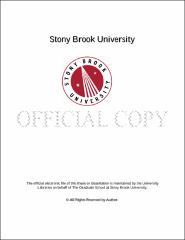| dc.identifier.uri | http://hdl.handle.net/11401/76317 | |
| dc.description.sponsorship | This work is sponsored by the Stony Brook University Graduate School in compliance with the requirements for completion of degree. | en_US |
| dc.format | Monograph | |
| dc.format.medium | Electronic Resource | en_US |
| dc.language.iso | en_US | |
| dc.publisher | The Graduate School, Stony Brook University: Stony Brook, NY. | |
| dc.type | Dissertation | |
| dcterms.abstract | Over the last few decades environmental pollution and energy consumption has been increasing as a result of a rapidly growing population and global industrialization. Consequently, finding novel and eco-friendly methods of cleaning the environment and exploiting clean energy sources has become a necessity. This thesis focuses on nanostructured materials that are tailored to provide affordable and efficient means for environmental remediation and which may also facilitate clean energy production. Identifying and synthesizing the appropriate nanomaterials in large scale are key issues that determine the adoption of nanotechnology solution to environmental problems and sustainability. This work has identified nanostructured metal oxides photocatalysts of the CuO and/or WO3, TiO2 to be appropriate and advanced nanomaterials for the water clean up from pollutants (such as petroleum hydrocarbons and chemical dyes) and the novel synthesis and characterization of these materials is described in detail. Commercial photocatalyst are based on titania which respond only to the UV (part of the solar spectrum) which is only 5% of total solar energy A major effort is currently underway worldwide to develop visible light-activated photocatalyst. One approach is by doping TiO2 with CuO as describe in chapter 3 and another through the synthesis of novel photocatalyst see chapters 4 and 5. At first, CuO-TiO2 nanofibrous mats were fabricated by blend electrospinning using a sol-gel precursor. The photocatalytic activities of the pure TiO2 and CuO-TiO2 nanofibrous mats catalysts have been demonstrated under UV light and under visible light. The UV-Vis spectroscopy results indicated that, based on the degradation of methylene blue (MB) dye solutions, the nanofibrous mats are strongly effective visible-light activated photocatalysts that offer 97% dye degradation under such irradiation. The relatively high photocurrent-to-dark-current contrast ratio and the fast responses observed also suggest that the CuO-TiO2 nanofibrous mats described are potentially useful for highly efficient visible light-activated photocatalysts for environmental and energy applications. CuO nanogrids were synthesized by direct thermal oxidation of composite substrates consisting of a Cu mesh and PVP nanofibers deposited on it by electrospinning. The unique nanogrids architecture results from the templating action of electrospun nanomats of polymers deposited on the metallic mesh. The estimated band gap energy is ~1.33eV, which is larger than the reported value for bulk CuO (Eg= 1.2eV). CuWO4 (n- type)-CuO (p-type) nanostructured photocatalysts were synthesized by sol-gel processing. The CuWO4-CuO nanocatalysts are 20-800 nm of diameter with porous surfaces. Photocatalytic test on benzene degradation under natural light showed that a reduction in the concentration of benzene from 43,825 to 2.8 ppm within 3 days. The photocatalytic degradation of methlyene blue using the CuWO4-CuO system resulted in 80% reductions which is better (and faster) that commercial TiO2. The CuWO4-CuO catalyst generated a photocurrent 140 nA/cm2 under simulated sun light with 0.1 M benzoic acid/0.1 M KOH. Finally, nonwoven cellulose acetate (CA) nanofibrous mats were prepared by electrospining process for selective oil sorbent to be interfaced with the photocatalytic nanogrids. The morphology and chemical analysis have done by scanning electron microscope (SEM) and Fourier transform infrared spectroscopy (FT-IR). The sorption capacity results of the CA nanofibrous sorbent for No. 6 fuel oil, vegetable oil, and benzene showed 44, 33, and 22 g/g, respectively. The CA mats have hydrophobic surface with a contact angle 137o and high buoyancy. The electrospun CA fiber mats is biodegradable, high sorption capacity, fast, and cost-effective solution to remediate oil spill in aqueous environment and potential template of nanostructued catalysts. The results of the work in this thesis provide very useful information on the impact of morphology and chemical composition on nanostructured metal oxide for catalytic activity. The mechanism we found here could help in the design and tailoring of new types of nanostructured metal oxide for energy and environmental remediation applications. | |
| dcterms.available | 2017-09-20T16:50:01Z | |
| dcterms.contributor | Gouma, Pelagia-Irene (Perena) | en_US |
| dcterms.contributor | Alkhader, Maen | en_US |
| dcterms.contributor | Haynes, Aisha S. | en_US |
| dcterms.contributor | Liu, Mingzhao. | en_US |
| dcterms.creator | Lee, Jusang | |
| dcterms.dateAccepted | 2017-09-20T16:50:01Z | |
| dcterms.dateSubmitted | 2017-09-20T16:50:01Z | |
| dcterms.description | Department of Materials Science and Engineering. | en_US |
| dcterms.extent | 141 pg. | en_US |
| dcterms.format | Monograph | |
| dcterms.format | Application/PDF | en_US |
| dcterms.identifier | http://hdl.handle.net/11401/76317 | |
| dcterms.issued | 2015-08-01 | |
| dcterms.language | en_US | |
| dcterms.provenance | Made available in DSpace on 2017-09-20T16:50:01Z (GMT). No. of bitstreams: 1
Lee_grad.sunysb_0771E_11588.pdf: 3434718 bytes, checksum: 2224811463be9bcb20ede3f552e4df02 (MD5)
Previous issue date: 2013 | en |
| dcterms.publisher | The Graduate School, Stony Brook University: Stony Brook, NY. | |
| dcterms.subject | Materials Science | |
| dcterms.subject | Metal oxide, Nanostructure, Photocatalysis, Water remediation | |
| dcterms.title | Synthesis and Characterization of Nanostructured Metal Oxide for Water Remediation and Energy Applications | |
| dcterms.type | Dissertation | |

